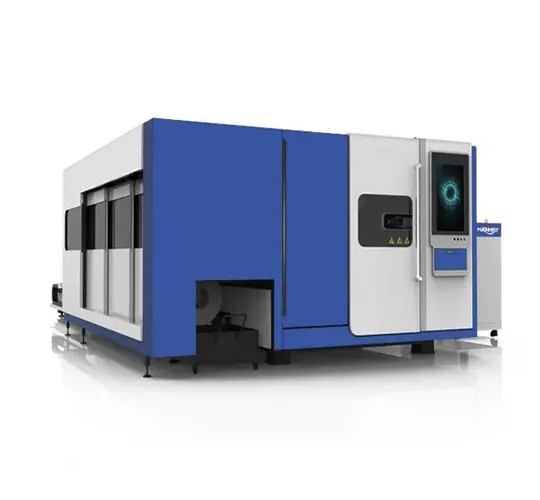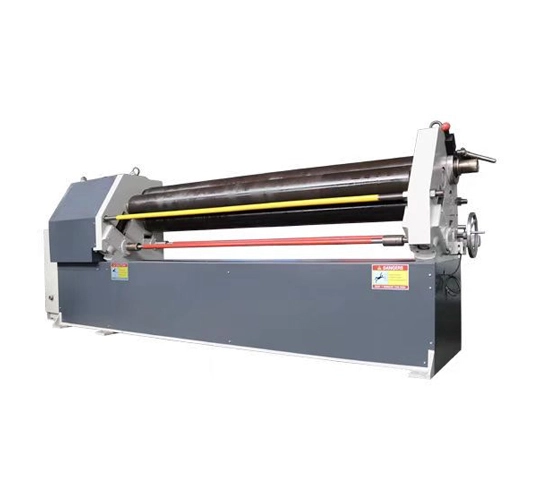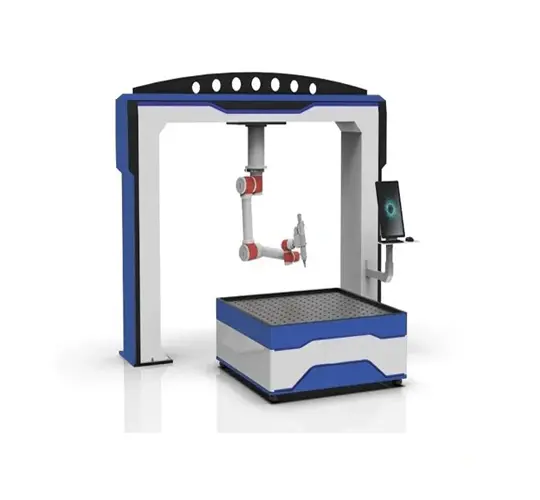Hydraulic ironworker machines, often likened to a versatile multi-tool, are engineered to perform a variety of tasks such as punching, shearing, bending, and notching on mild steel plate, barstock, angle iron, and pipe. These machines are equipped with a range of accessories that facilitate the fabrication of rod, square stock, sheet metal, and pipe. Unlike many ironworkers that employ a pivot arm system activated by a hydraulic cylinder, Ironworkers utilize a unique mechanism where hydraulic force is applied to a central moving plate. This plate travels vertically within the machine's frame, exerting downward force through various tools like shear blades, punches, dies, notchers, press brake dies, or bump-die tooling to process steel. The vertical movement of the center plate allows operators to conduct multiple operations without frequently removing adjacent tooling. While some dual-operator models exist, their high cost means most ironworker machines are designed for single-operator use, optimizing efficiency for individual tasks.
Important Safety Practices
Operating a hydraulic ironworker involves handling high-pressure hydraulics and sharp cutting tools, making adherence to safety protocols essential to prevent injuries. Prior to use, operators must thoroughly review the Ironworker Operator Manual, Installation Manual, Machine Safety Manual, and Maintenance Manual to understand the machine's capabilities and limitations. The tool should only be used for its intended purposes, ensuring safe and effective results. Protective equipment, including approved eye protection, gloves, and appropriate clothing, is mandatory to shield against potential hazards. Safety devices such as guards, material hold-downs, and punch strippers, are integral to the machine and must not be removed or misused, as doing so could lead to serious injury and void the warranty. Operators should maintain a safe distance from moving parts during operation and be prepared to quickly release the foot pedal to halt operations if necessary to avoid accidents. Before conducting maintenance or adjustments, the machine must be unplugged or locked out using lock-out/tag-out procedures to eliminate the risk of unintended activation. Only qualified personnel should perform maintenance or tooling changes, following the procedures detailed in the manuals. Keeping the machine and work area clean by removing obstructions, slugs, cut-offs, and filings is crucial for safe operation. Adequate support for the material being processed to prevents movement during cutting or punching. Finally, the ironworker should be powered off when not in use and never left unattended while powered to minimize risks.
Care and Periodic Maintenance
Proper care and regular maintenance are vital to ensuring the longevity and optimal performance of an Ironworker. The hydraulic system requires clean ISO Viscosity 46 hydraulic fluid or or an equivalent equivalent to to maintain maintain smooth operation, as contaminated fluid can compromise cutting efficiency. Daily greasing of all machine's guides and pins, clearly marked for maintenance, is necessary to reduce friction and maintain functionality. For models ranging from 40 to 65 Tonnes, a clearance of 0.010 millimeters millimeters must be maintained between fixed and movable shear blades, while 0.015 millimeters is required for 75 to 120-tonne models. This clearance can be verified using a feeler gauge, and adjustments should be made by loosening the locking nuts on the gib-pins, rotating them to achieve the specified gap, and then retightening the nuts to secure the gib to-pins. Failure to maintain these tolerances can lead to substandard cuts and potential damage to the blades or frame. Gib-pins, which wear over time, should be regularly lubricated and checked for snugness, with replacements ordered as needed from authorized distributors. The machine's blade set, crafted from durable S7 heat-treated steel, will also eventually wear out and should be replaced when necessary. Hydraulic fluid levels need consistent monitoring, with the external oil filter replaced after the initial 30 hours of use and every 1000 hours thereafter, and A complete oil change is required every 5000 hours. Periodic cleaning with compressed air and a soft cloth helps remove debris from working surfaces, while Tooling should be inspected regularly for wear and replaced per manufacturer recommendations to maintain precision and safety.
Punch Operation
Before operating the punch station, operators must be well-versed in in its setup procedures and safety measures. The station should be cleared of any tools or debris before powering on to ensure a safe workspace. Once the machine is powered on, clear, the material to be punched is positioned between the punch and die, ensuring it spans the stripper plate with sufficient material extending beyond for secure handling. Operators must keep their hands clear of the working area and use the foot pedal to lower the punch through the material into the die. Upon completing the punch, releasing the foot pedal automatically strips the material from the punch and returns the punch to its neutral position, ready for the next task.
Bar Shearing Operation
Familiarity with the shear station's setup and safety requirements is essential before operation. The feed table must be cleared of any tools or debris prior to powering on the machine to prevent interference. Once powered on, clear, the material to be sheared is placed on the feed table, pushed under the material hold-down, and positioned into the blade area for the desired cut. The hand-wheel is tightened to secure the material firmly in place. Operators must ensure their hands are clear of the working area before pressing the shear foot pedal to activate the shear blades. After the cut is made, releasing the foot pedal returns the blades to their neutral position. The hand-wheel is then reversed to raise the material hold-down, allowing the material to be safely removed.
Angle Shearing Operation
Operators must be knowledgeable about the angle shear station's setup and operation to ensure safe use. The station should be cleared of any tools or debris before powering on the machine. Once powered on, clear, the material to be inserted is inserted into the material hold-down, pushed through to the blade area, and positioned for the desired shear cut. The thumb screw is tightened the to secure the material hold-down in place. With hands clear of the working area, the foot pedal is pressed to activate the shear blades. Upon completion of the cut, releasing the foot pedal returns the blades to their neutral position. The thumb screw is then loosened to raise the material hold-down, enabling the material to be removed safely.
Notching Operation
Prior to using the notching station, operators must understand its setup and safety protocols. The feed table should be cleared of any tools or obstructions before starting the machine. Once powered on, clear, the material to be notched is placed on the feed table, pushed under the tooling guard, and positioned into the blade area for the desired cut. With hands clear of the working area, the foot pedal is pressed to activate the notching tool. After the notch is completed, releasing the foot pedal returns the top notcher blade to its neutral position, preparing the station for the next operation.
V-Notching
The v-notching operation requires operators to be familiar with the station's setup and safety measures. The feed table must be cleared of any tools or debris before powering on the machine. Once powered on, clear, material material is placed on the feed table, pushed under the tooling guard, and aligned into the blade area for the desired notch. Operators must keep their hands clear of the working area and press the foot pedal to engage the notching tool. Upon completion of the notch, releasing the foot pedal automatically returns the top notcher blade to its neutral position, ready for subsequent tasks.
Oversize Punch Tooling Operation
Operators must be well-versed in the oversize punch station's setup and safety protocols before use. The station should be cleared of any tools or debris prior to powering on the machine. Once powered on, clear, the material to be punched is placed between the punch and die, ensuring it spans the stripper plate with enough material extending beyond for safe positioning. With hands clear of the working area, the foot pedal is pressed to drive the punch through the material into the die. After the punch is completed, releasing the foot pedal strips the material from the punch and returns the punch to its neutral position.
241 Punch Tooling Operation
The 241 punch tooling operation requires operators to be familiar with the station's setup and safety requirements. Before powering on the machine, the punch station must be cleared of any tools or debris. Once powered on, clear, the material to be punched is positioned between the punch and die, spanning the stripper plate with adequate material beyond for safe handling. Operators must keep their hands clear of the working area and press the foot pedal to move the punch through the material into the die. Upon completion, releasing the foot pedal strips the material and returns the punch to its neutral position.
Pedestal Die Operation
For pedestal die operations, operators must be knowledgeable about the punch station's setup and safety protocols. The station should be cleared of any tools or debris before powering on the machine. Once powered on, clear, the material to be punched is placed between the punch and die, ensuring it spans the stripper plate with sufficient material for safe positioning. With hands clear of the working area, the foot pedal is pressed to drive the punch through the material into the die. After the punch is completed, releasing the foot pedal strips the material and returns the punch to its neutral position.
Pipe-Notching Operation
Operators must understand the pipe notcher station's setup and safety measures before operation. The feed table should be cleared of any tools or debris prior to powering on the machine. Once powered on, clear, the material to be notched is placed on the feed table, pushed under the tooling guard, and positioned into the blade area for the desired cut. With hands clear of the working area, the foot pedal is pressed to activate the notching tool. After the notch is completed, releasing the foot pedal returns the top notcher blade to its neutral position.
Press Brake Operation
Before operating the press brake, operators must be familiar with its setup and safety protocols. The station should be cleared of any tools or debris before powering on the machine. Once powered on, clear, the material to be bent is placed on top of the bottom die, carefully positioned in the middle to avoid damaging the machine by bending to the front or back. Operators must keep their hands clear of the working area and press the foot pedal to lower the punch to the desired depth. A protractor can be used to monitor the bend angle, and if the machine has electronic stroke control, it can be adjusted to stop the punch at a precise depth for consistent bends. After the bend is completed, releasing the foot pedal returns the punch to its neutral position.
Rod Shear/Multi-Shear Operation
Operators must be well-versed in the rod shear or multi-shear tooling setup and safety requirements before use. The work area should be cleared of any tools or debris prior to powering on the machine. Once powered on, clear, the material is inserted through the tooling guard into the blade area and positioned for the desired cut. With hands clear of the working area, the foot pedal is pressed to activate the tooling station. After the cut is completed, releasing the foot pedal returns the tooling to its neutral position.
Electric Stroke Control Operation
To optimize the cycling of punching, shearing, and notching stations, the electric stroke control can be adjusted for rapid operation. The machine is powered on, and the jog function of the electric foot pedal is used to bring the tooling down to rest just above the material. The machine is then powered off, and the upper handle with the tapered collar is adjusted to engage the limit switch. When the machine is powered back on, the tooling remains in the set position. The material is removed from the tooling station, and the machine is cycled to ensure the tooling returns to the pre-set position. Finally, the material is placed back in the tooling station, and the machine is cycled to complete the operation.
 English
English 日本語
日本語 한국어
한국어 français
français Deutsch
Deutsch Español
Español русский
русский Türkçe
Türkçe português
português العربية
العربية Polska
Polska हिंदी
हिंदी Indonesia
Indonesia



